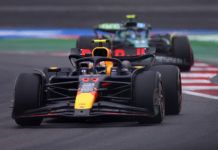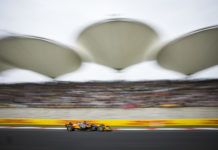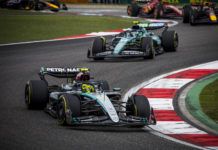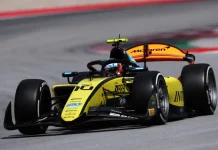Valtteri Bottas reckons DRS will be more powerful with the less effective slipstream effect in F1 2022 as George Russell and Lando Norris stated.
The new technical rules introduced for 2022 have seemingly increased the power of the famed DRS or to give it its full title: Drag Reduction System. This is the opinion of Alfa Romeo new boy and 10 time Grand Prix winner Bottas.
Not just that but the Finn also believes overtaking should become easier and there is an improvement with cars running more closely together when cornering but also stated that benefits following another car on a straight has been decreased.
However, he believes another consequence of the changes to this year’s cars is that drivers get a larger increase in straight-line speed from their DRS. Bottas believes this will make up for the reduced slipstream effect on straights that multiple drivers reported during the first test in Barcelona.
However, owing to not getting close to other cars, Bottas admitted he “didn’t get that much experience” of running close to other cars, having covered the lowest mileage of any drivers testing. “I didn’t get super-close to other cars,” he said at the launch event.
“The only thing I could feel was once I was maybe four seconds away, in the previous generation of cars you would already feel a deficit in the corners and you could feel the turbulent air, but in that distance with the new cars it definitely felt like less effect. But that’s pretty much as close as I got”.
“I did chat with some other drivers, they say they got close, they said they had less slipstream effect. We’ll see, we’ll find out in Bahrain. But also I think it’s an important point that the DRS effect is bigger this year because of the wider wing so maybe that will compensate the small loss of the slipstream,” summed up Bottas.
The man who took the place of Bottas at Mercedes, George Russell does feel though that the reduced slipstream on the 2022 cars might reduce overtaking. “I think following has been improved, but the slipstream effect has been reduced quite substantially, I think,” he said.
“I think we can follow closer, but from what we’ve seen, the slipstream effect is definitely less effective. I got right up behind Lando during Barcelona test, and I was a car length or two behind him going down the straights, so that was slightly concerning but let’s see.”
McLaren’s Norris is in agreement. “I think me and George had a perfect demonstration of it,” he said. “I didn’t want to let him past while he was on a quick lap, so I screwed him over and had him off a bit! That’s what you do in testing.
“George said it correctly – I definitely think the following part in the corners is an improvement. How much exactly is hard to know, because you’re always on different fuel levels and tyres and stuff. And maybe when there are two, three, four, five, six cars ahead it could be quite different again.
“But all of this obviously comes with the deficit of a slipstream effect, and how much that is going to be helping us. So, we can follow closer, but then the slipstream is worse, so there is positive and a negative from it. Don’t know which one is the bigger effect at the minute, so we’ll have to wait and see until the first race,” summed up Norris.
Here’s F1 teams defending crypto
Here’s the F1 Barcelona Test stats
Here’s George Russell on test
Here’s George Russell on porpoising



















